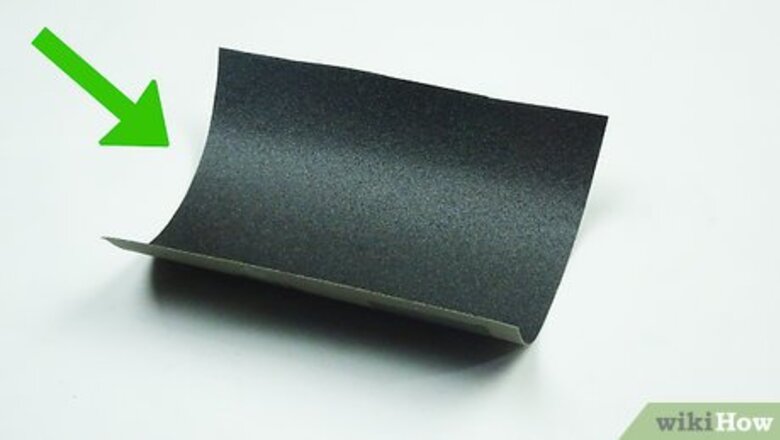
views
Sharpening Your Scissors With Sandpaper
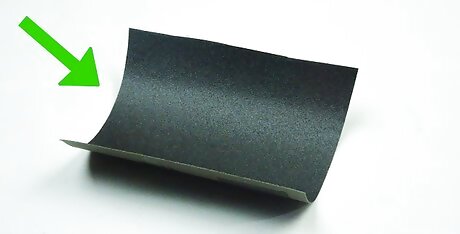
Obtain a piece of sandpaper. A sandpaper sheet with 150-200 grit will work just fine, but you could even go for a little bit of a finer grit (bigger grit number) if you want smoother edges to your scissor blades. Fold the sandpaper in half, with the rough sides facing outward. Have the rough edges face outward, so the sandpaper grazes against both blades as you cut the paper.
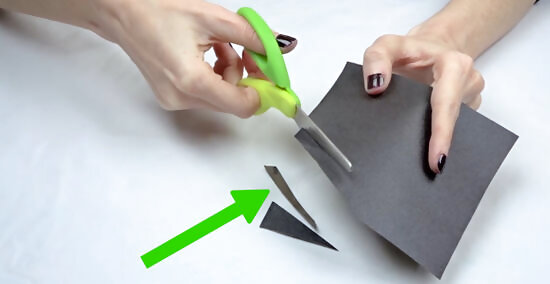
Cut through the sandpaper. Cut through the sandpaper, cutting long strips, about 10-20 times. You will notice that the blades become sharper with every strip of sandpaper cut. Use full scissor strokes, beginning the cutting at the base of the scissors and extending to the tip. Cutting through sandpaper is good for scissors that aren’t horribly dull, but just need some touch up sharpening. The sandpaper also helps smooth out nicks and indents on the blades. Some alternative cutting materials to sharpen scissors are emery cloth and steel wool.
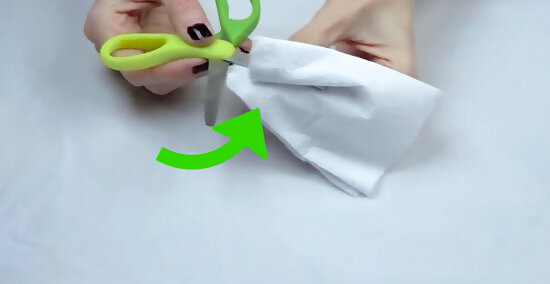
Wipe down the scissors. Wipe down the blades of the scissors using a damp paper towel to clean off any sandpaper bits that may have collected on the blades while sharpening the scissors.
Sharpening Your Scissors With Aluminum Foil
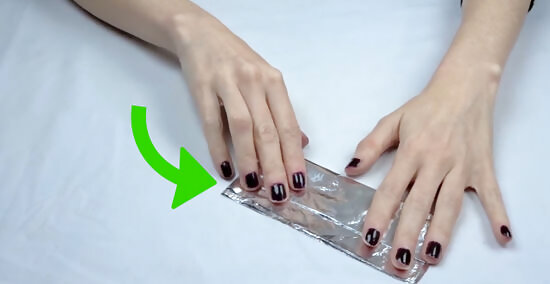
Obtain a piece of aluminum foil. Take a piece of aluminum foil, about 8-10 inches long, and fold it lengthwise multiple times so you have a thick, folded strip of foil. The added layers of the aluminum foil will help sharpen the blades of the scissors multiple times with every cut of the foil.
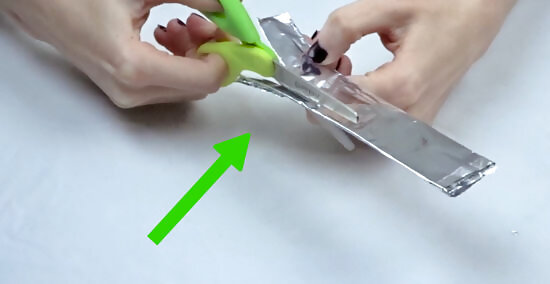
Cut the foil. Cut strips of the aluminum foil with your scissors until you have cut the entirety of the thick aluminum strip. Use full scissor strokes, cutting beginning at the base of the scissors and extending to the tip. Depending on the width of the strips you cut, you can sharpen your scissors blades a lot (by cutting many, skinny strips) or just a little bit (by cutting a few, thicker strips).
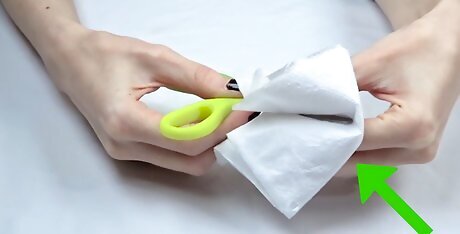
Wipe down the scissors. Wipe down the blades using a paper towel dampened by warm water. This will get rid of any aluminum debris that may have clung to the blades as you were cutting.
Sharpening Your Scissors With a Sharpening Stone
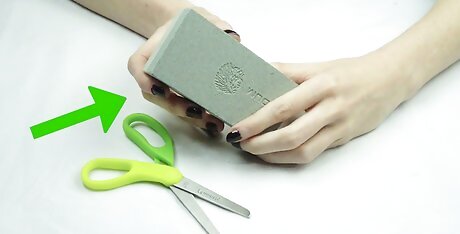
Obtain a sharpening stone. Sharpening stones can be found at most hardware stores, and can be used to sharpen any blade you have. Sharpening stones normally have two sides used for sharpening blades: a coarser, grainier side, and a fine side. If you have very dull scissors, you should start out using the coarse side of the stone, and then use the finer side of the stone to finish your sharpening. If your scissors just need a light sharpening, you only need to use the fine side of the stone.
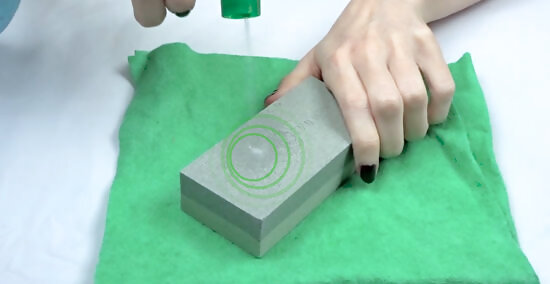
Prepare the sharpening stone. Place a towel underneath your sharpening and lubricate it with either water or honing oil. Stores sell “honing oil” in the same area that they sell sharpening stones, but any oil, or even water for that matter, works just fine for lubricating the stone.
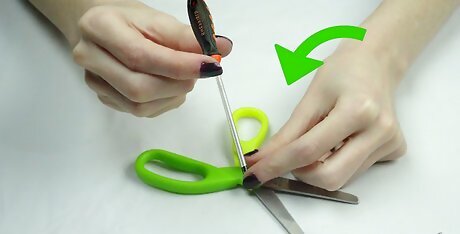
Disassemble your scissors. Remove the screw attaching the scissor blades together. You do this so you can sharpen each blade separately, and have more mobility when sharpening the blades. More often than not, a flathead screwdriver small enough to fit in the screw’s head will work in unscrewing the scissors’ blades from each other.
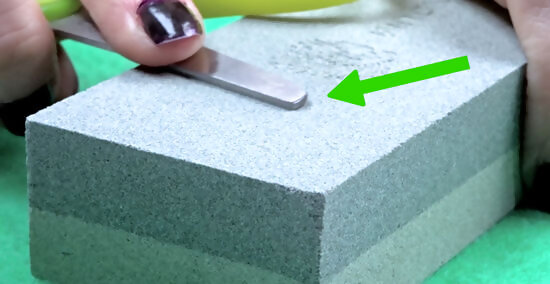
Sharpen the inner side of the blade. Place one blade of the scissors on the stone with the inner side of the blade (the flat, inside part of the blade that comes in contact with the material you’re cutting and the opposite inside part of the other blade), facing down. You want to create a nice, sharp angle between the inner blade (the part you’re currently sharpening), and the cutting edge (the top edge to the inner side of the blade). Where those two edges meet, is the area that needs to be sharp to cut things. Grip the handle of the scissor blade, and slowly pull the blade across the stone toward you, keeping the edge of the blade flat against the stone. Repeat this action slowly and carefully until the blade has been sharpened. This should take about 10-20 pulls. Repeat this step with the other blade of the scissors. You should practice on some old scissors until you fully get the hang of how to sharpen blades.
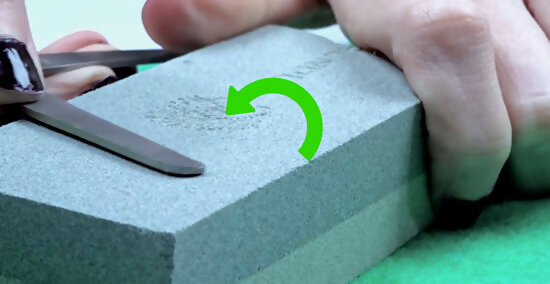
Sharpen the cutting edge of the blade. Grip the handle of the scissor blade, and tilt the blade toward you until the cutting edge (the beveled edge that meets the inner side of the blade) lies flat on the stone. With the blade horizontal to you, slowly pull the blade across the stone toward you, keeping that beveled edge flat against the stone. Match the angle as closely as possible and continue to slide the blade forward. Repeat this action carefully until the blade is sharpened. If you started on the coarse side of the stone, finish with a few swipes on the finer side of the stone to give a nice, smooth finish. If you have never sharpened scissors this way before, you might find it difficult to judge when the edge of the blade is completely sharpened. Consider this trick: before you start sharpening the blades, run the tip of a permanent marker across the edge of the scissor blade. Start sharpening the blade, and when the marker line has been sanded away off the edge, you’ve successfully sharpened the blade.
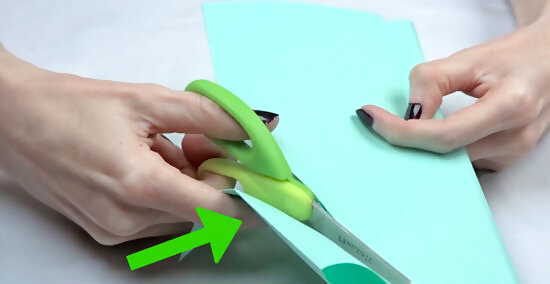
Remove the burrs on the scissor blades. When you’re finished sharpening the scissors, there might be some rough burrs of metal along the sharpened edges of the blades. These burrs can easily be removed by putting the scissors backs together, and opening and closing them a few times. Then use the scissors to cut through some kind of material like paper, cardboard, or fabric. This will further ensure the little burrs get knocked off the blades. If the scissors are sharp enough for your liking, you’re finished. If you want them to be sharper, repeat the sharpening process.
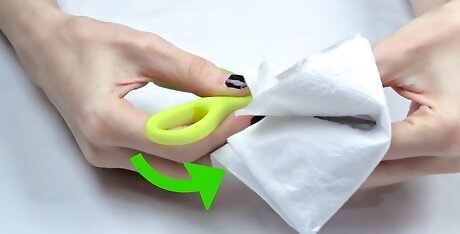
Wipe down the scissors. Use a damp paper towel to wipe down the blades of the scissors and clean off any stone bits that may have collected on the blades while you sharpened the scissors.
Sharpening Your Scissors With a Glass Mason Jar
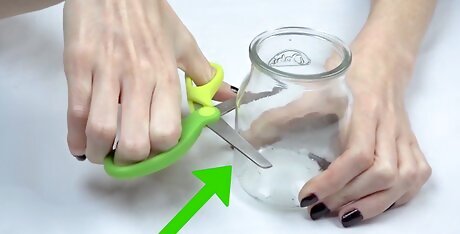
Fit the scissor blades around the mason jar. Open the pair of scissors as wide as they can go, and position the blades around the sides of the mason jar. The jar should be as far as it can go between the two blades. Hold the jar with one hand, and the scissors with the other hand.
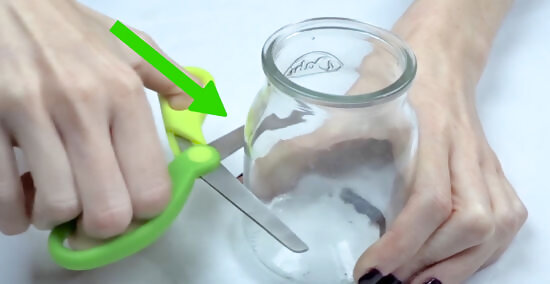
Cut the mason jar. Squeeze the scissors closed, and slide the mason jar out from between the blades as the scissors close. This is the same way you would close the scissors if you were cutting paper or fabric. Use light pressure to close the scissors, let the glass do the sharpening work for you. Repeat this process until the blades have a smooth, clean edge. Be sure to use a mason jar that you don’t mind damaging, because the blades of the scissors might leave scratch marks on the jar.
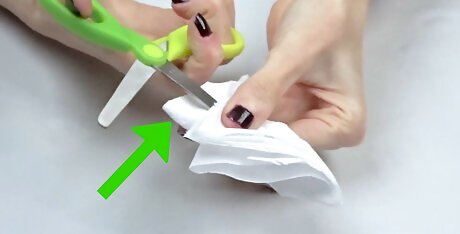
Wipe down the scissors. Using a damp paper towel, wipe down the blades of the scissors to clear off any microscopic glass pieces that may have gathered on the blades while you were cutting the mason jar.
Sharpening Your Scissors With a Pin
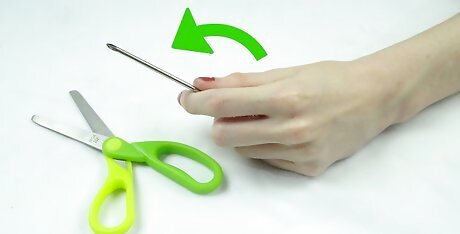
Obtain a sewing pin. This method follows the same principle of using a mason jar to sharpen your scissors, while utilizing a smaller tool.
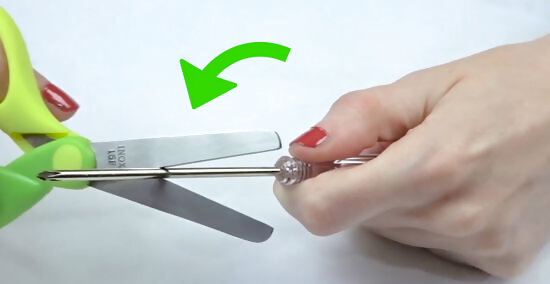
Cut the pin. Squeeze the scissors closed, and slide the pin out from between the blades as the scissors close. This is the same way you would close the scissors if you were cutting paper or fabric. Use light pressure to close the scissors, let the metal pin do the sharpening work for you. Repeat this process until the blades have a smooth, clean edge.
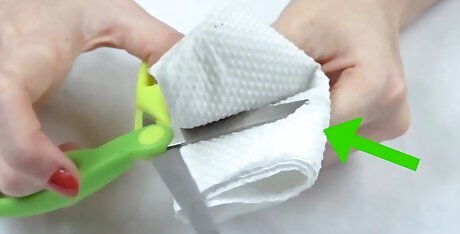
Wipe down the scissors. Using a damp paper towel, wipe down the blades of the scissors to clean off any metal bits that may have collected on the blades while cutting the pin.















Comments
0 comment